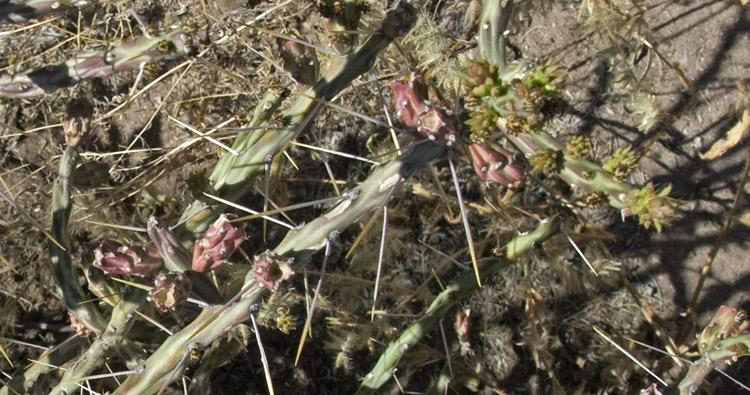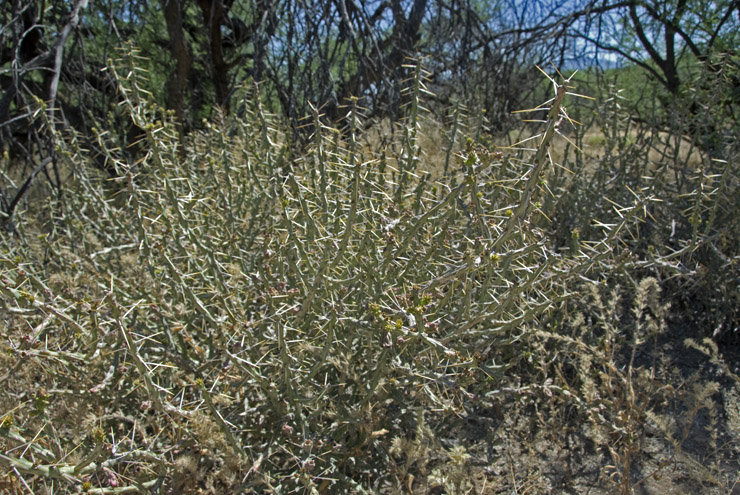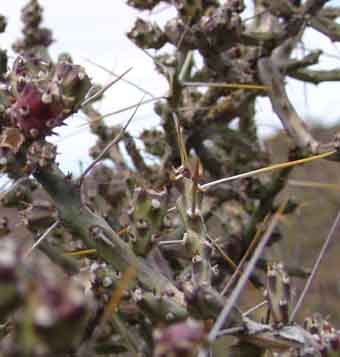Cholla (Cylindropuntia species)
These cacti have stem joints that are cylindroid in shape, and run in size from shrubs to small trees (most of the specimens on our lands are fairly small shrubs). Branches may develop from any areole. Glochids are usually small and inconspicuous. In most of our area, Chollas are not very common on our lands, appearing most often individually, in quite scattered distributions. We know of one exception to this -- the Jumping Cholla, see below. The two most conspicuous forms that we have -- the Buckhorn and Staghorn Chollas -- are sometimes hard to distinguish -- they both have many thin branches arising from the ground or from a short trunk, and their flowers are quite variable in color -- but the following descriptions and images should provide an adequate guide. Staghorn cholla is much more common than Buckhorn on our Eastern Uplands.
Staghorn Cholla (Cylindropuntia versicolor)
Staghorn tubercles are fairly prominent visually and 3 to 5 times as long as they are broad (note the banner photo at the top). Spines number about 7 to 10 per areole, are 1/4 to 5/8" long, tend to be reddish and spread in all directions. Flowers tend to be larger than the Buckhorn. Examples from May 2004 are shown below. Click on each image to enlarge it. In the enlargement at right, note the new, purplish growths emerging out of the areoles -- these are ephemeral leaves.
 ..
..
The buds of this Cholla are edible. For more details on Cholla bud harvesting and processing, see this link: Daniel Baker's Wildfoods Logbook.
But the fruits are the most distinctive indicator: Staghorn cholla fruit is fleshy when mature, usually spineless, and stays on the plant for more than a year.
 ..
..

Note in the above photographs how few the spines are per areole and how short they are. Also, the plants continue to hold old fruit from last year (even as the new growth is beginning this spring -- visible in the top-most right hand image when it is enlarged).
 At left, new annual growth appears on a Staghorn Cholla after rains, in August of 2003.
At left, new annual growth appears on a Staghorn Cholla after rains, in August of 2003.
Buckhorn Cholla (Cylindropuntia acanthocarpa)
Buckhorn spines number up to 25 per areole, tan to straw-colored, and the longer ones are up to 1 1/2" long. Flowers are smaller than the Staghorn, and their anthers are dark red. Mature fruits are dry, deeply tuberculate, and covered with numerous long spines. The fruits fall within several months of maturity.
 ..
..
Note in the above photos (especially the enlargement at right) the numerous spines per areole and the much greater length of the spines. The contrasts in spine patterns are even more striking in these two images below -- indeed, in the left image the tubercles are almost entirely obscured by spines; note also, in the photo at right, the now-ripe fruit at the top, with its definite spines.
 ..
..
 At
right, a Buckhorn Cholla displays new budding growth. Again, note (in the enlargements) the broader shape of the tubercles compared with Staghorn.
At
right, a Buckhorn Cholla displays new budding growth. Again, note (in the enlargements) the broader shape of the tubercles compared with Staghorn.
Christmas Cholla (Cylindropuntia leptocaulis)
This is a short, open-branching and thin-stemmed shrub (the stems are about 1/8" thick) that may reach 2 feet tall. Each areole has one very long spine (2") and many glochids (see below, and note the yellowish tip on the spine). Flowers open in May-June and are typically pale yellow; the small fruits are bright red and persist through the winter, hence the "Christmas Cactus" popular name -- see left and left-below. Note also the new sprouts and leaves on the left-below enlargement.

Here is an image of a whole mature plant. Click on the image for a close-up.

Pencil Cholla (Cylindropuntia kleiniae)

This is a very rare cholla on our Saguaro-Juniper lands. Note its similarity to the Christmas Cactus further above in that it has very long, often single spines, which are also yellow-tipped. But the cactus here photgraphed (in the mesquite bosque just above the floodplain in Lower Hot Springs Canyon) is a massive shrub more than three feet high (apparently they can reach 7 feet, (Benson pp. 59-60):

Also, as its banner photograph shows, the fruits do not evolve into the berry-shaped, bright-red fruits like the Christmas Cactus, but remain more green-and-red and less juicy.
Jumping Cholla (Cylindropuntia fulgida)

This is our largest cholla, reaching heights of more than 10 feet. It has numerous, large, and very sharp barbed spines, which facilitate the detachment of the spiny joint when a spine penetrates the skin or clothing of a passerby. The whole plant stretches a bit before detachment occurs, so the spiny joint seems to leap onto the body part of unfortunate humans, whose imaginations have generated the name "Jumping". Stems that have attached themselves to the body of a victim are quite hard to remove, tending to "jump" (for example) to the snout of a dog that tries to remove it from its paw with its teeth, or to the hand of a person who tries to remove it from her arm..
While Jumping Cholla bears small flowers and fruits with seeds, reproduction more typically occurs when the joints or fruits detach from the plant, fall to the ground, and sprout new joints at short distances from the mother plant, sometimes rolling a ways on a slope.

For this reason, Jumping Cholla tends to form dense "forests" of the same plants in limited locales. The images presented here all come from an extensive stand, located along a high terrace above the San Pedro River north of Redington, past Milepost 32 where the Pima and Graham County lines meet. The terrace lies more than a hundred feet above the river at this point; you can see the cliffs on the far side of the river in the banner photo above. Here, below, is a single plant, the whole plant on the left, and on the right a closer view of the tendency of this cholla to form a distinctively large and dense clustering of fruits.
 ....
....
At present, we have no good current pictures of Jumping Cholla from Saguaro Juniper lands proper, but see Nancy Ferguson's Field Notes (October 2001) for further ecological comments on a location where we do have them. Nancy observes that various species of Cholla often serve as predator-deterring nest sites for a variety of birds. For example, see this Staghorn Cholla on a terrace of Lower Hot Springs Canyon. Click on the image to enlarge it.

And for a really elaborate use of cactus thorns for nest-building, see the images and discussion in our page on Mockingbirds and Thrashers.
Return to Cacti


